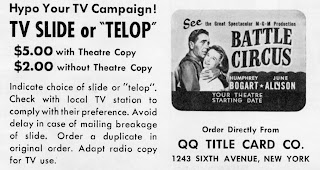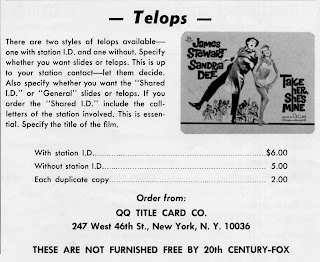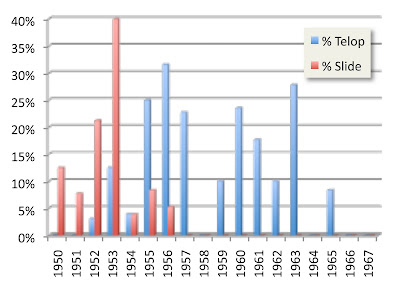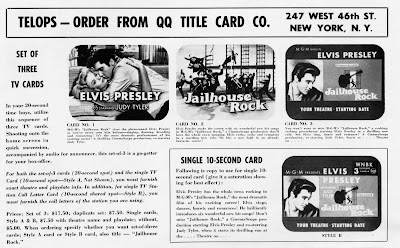Slides on TV? Don’t Touch That Dial!
October 18, 2010

The use of lantern slides to advertise coming attractions in the United States faded out in the 1950s, but the medium had not quite gasped its last breath. Just as the rise of television brought motion pictures into the family living room, coming attraction slides came along for the ride. These static images were used to advertise upcoming films and programs during broadcast station breaks in very much the same way that slides were used within the cinema to display advertising between films, and in the early days, between reels.
Over the past week I have surveyed the collection of Exhibitors Manuals (also known as "Promotion Manuals" or "Showman's Guides") at the Pacific Film Archive (PFA). These manuals were (and are) created by film distributors and provided to theatre operators to assist them in building promotional campaigns. One particularly useful aspect of these guides is that each contains photos and detailed listings for the publicity material that was created for any given title, such as: posters, lobby cards, photo stills, banners, handbills, advertising copy, and (of course) slides. This information not only indicates whether slides were created for a specific film, the data can also be aggregated to provide insight into broader promotional strategies.

One surprising byproduct of my recent survey has been the discovery of "Telops" slides, which were essentially the television based replacement for in-cinema slides.
These slides were broadcast on-air to promote currently playing motion pictures and generally featured an announcer's voice-over while the static image occupied the screen. These spots typically lasted 10 or 20 seconds and often included the broadcaster's station identification announcement. In fact, the slides were often offered with or without the option of having the broadcaster's identification included on the slide.
The earliest instance of a Telop slide in the PFA's collection of over 800 exhibitor guides is Goldwyn's 1952 production of Hans Christian Andersen, and the latest instance is (of all things) 20th Century Fox's 1965 teenage romp, Wild on the Beach. I have found no further instances of Telop slides within the PFA collection later than 1965.
As the graph below indicates, the appearance and timing of these Telops slides coincides almost exactly with the demise of in-cinema slides. In cinematic terms, slide use in the mid-1950's essentially did a cross-fade from cinema audiences to the television audience. Within their collection, the PFA has 348 exhibitor manuals from the years 1950-1967. While admittedly this is not a true random sample of American cinema during this period, calculating a percentage of films which included a cinema slide as a promotional item versus those that utilized a Telop slide, clearly indicates the change-over that occurred during that time frame.

One aspect of this transition is that slides no longer held the privileged position of being exclusively displayed to cinema audiences. Instead, slide promotion left the cinematic venue and entered the home. With that transition, slides no longer spoke to cinema audiences, but to prospective audiences. Telops slides were to indicate what was "now showing" at a cinema, rather what would be coming in the future to the venue in which they were already seated. In this respect Telops slides came to function not unlike newspaper advertising, displaying their promotional message at large in hopes of attracting an audience to the theatre.

One last observation on the Telops slides is that even within my relatively small sample set, it is obvious that Telops slides were created only by the larger studios and only for their higher budget productions. This stands to reason given the cost considerations of television advertising. While the only cost for in-cinema slide advertising was the 15-25 cents for the physical slide itself, the cost of broadcasting the same image on television would only make sense where a solid return on the investment could be reasonably assured.
Unfortunately I was unable to find video of actual coming attraction Telops broadcast (not surprising actually, I'd be shocked to learn that any were taped and/or that the tapes had survived), but here's a YouTube clip from ABC demonstrating the general idea...
